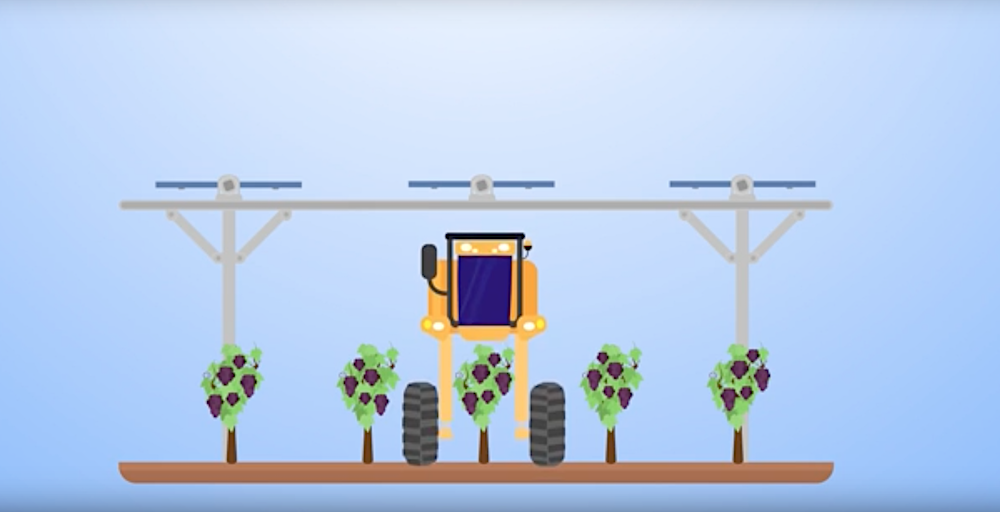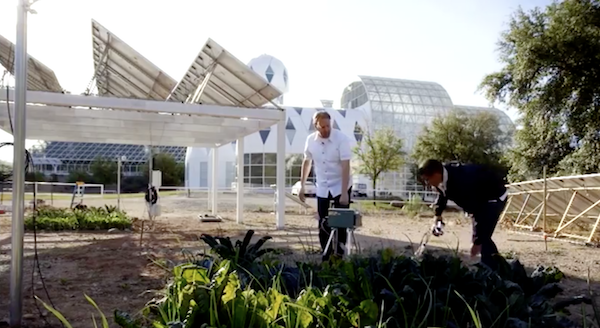
[Image above] Must we sacrifice our best farmland to advance solar cell technology? Researchers say agrivoltaics can resolve this either-or situation. Credit: Sun’Agri, YouTube
Not only is the rooftop solar panel market rapidly growing, supersized solar farms are as well.
United States bank Goldman Sachs says utility-scale solar power capacity is expected to grow by double digits globally in 2019 and 2020. “We expect the combination of lower costs for solar and favorable policy support providing a multi-year runway for utility-scale to drive meaningful upside to the market,” bank representatives explain in a research note, as reported in a Reuters article.
With low cost and favorable policies on their side, companies planning to pursue large-scale solar plants would appear to have a clear path to construction. Yet public opposition could throw a wrench in future plans.
A “not-in-my-backyard” mentality surrounding renewable energy has made it challenging for some companies to find land on which to build solar farms. That opposition is partly why “floatovoltaics,” the practice of installing photovoltaic (PV) panels on reservoirs rather than land, has gained traction.
One reason for public opposition to solar farms is the loss of farmland that accompanies development. Teresa Moore, interim executive director of the Valleys Planning Council (a land preservation group), aptly describes the quandary many farmers face in a Washington Post article. “The bottom line is: Solar is wanted, needed … [but] is it necessary to sacrifice our best farmland?”
However, solar farms and agriculture may not be an either-or situation. Instead, studies suggest agrivoltaics, the practice of co-locating PV infrastructure and agriculture by planting crops under PV panels, could create a mutually beneficial relationship.
The idea of agrivoltaics is not new—several demonstration and research installations are operating in Japan and France. However, the concept has become more attractive in recent years as PV prices have plummeted, interest in renewable energy has risen, and financial pressures on small farmers have grown.
In 2017, Greg Barron-Gafford, associate professor at the University of Arizona, and his team began experimenting with agrivoltaics by growing crops beneath 9-foot solar arrays at the university’s Biosphere 2. Their research was named a finalist by Fast Company magazine in 2018 for its World Changing Ideas Awards.
In an interview with the Ecological Society of America (ESA), Barron-Gafford explains why an agrivoltaic system is beneficial.
“In an agrivoltaic system, the environment under the panels is much cooler in the summer and stays warmer in the winters,” he says. “This not only lessens rates of evaporation of irrigation waters in the summer, but it also means that plants don’t get as stressed out.”
PV panels also benefit from the system. When water evaporates from the crops, creating localized cooling, it reduces heat stress on the panels overhead and boosts their performance.

More than 2,500 miles away, researchers at the University of Massachusetts (UMass) Amherst are also conducting agrivoltaic experiments.
Reporter Sarah Shemkus explains in a Civil Eats article on the Massachusetts research that “The short growing season along with high costs for labor and land can make farming in Massachusetts a financially precarious proposition.” Agrivoltaic systems could potentially ease several of these problems at once.
The UMass agrivoltaic research started in 2009 when construction company owner David Marley connected with UMass researchers to help him explore using farmland for solar arrays without interrupting the land’s agricultural use. They completed a 70-panel array at the UMass Agriculture Research Center in 2010, and the following year Marley formed private solar company Hyperion Systems to pursue the project further. When Marley died in 2013, his son James took over the business and continued partnering with UMass.
Both universities say a key to effective agrivoltaics is placing the PV panels high enough so tractors can access the site. “This was the first thing that farmers in the area said would have to be in place for them to consider any kind of adoption of an agrivoltaic system,” Barron-Gafford says in the ESA interview.
Minimal soil disruption is also key. The UMass panels are supported by vertical poles embedded 10 feet into the ground, so no concrete is used.
Crop selection is a final key to effective agrivoltaics. University of Arizona researchers found lettuce grown with agrivoltaics is comparable to monocultures; other plants that grow well in partial shade include hog peanut, alfalfa, yam, taro, cassava, and sweet potato. UMass researchers found vegetables such as peppers, broccoli, and Swiss chard can produce about 60% of the volume they would in full sun.
The researchers hope their research can assuage the fears that farmers have about solar farms taking over their land. “I think the primary reason more producers aren’t using this system yet is lack of awareness or uncertainty about its potential,” Barron-Gafford says.
